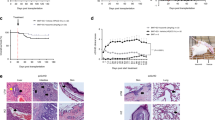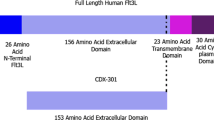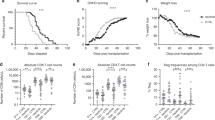Abstract
We and others have demonstrated that the milieu created by ionizing radiation (IR) used for conditioning plays a major role in the development of acute graft-versus-host disease (aGVHD). We reasoned that antioxidants that could inhibit IR induction of inflammatory cytokines and/or apoptosis might reduce the incidence or severity of aGVHD. Therefore, BALB/c mice were treated with amifostine, n-acetyl cysteine (NAC) or pyrrolidine dithiocarbamate (PDTC) prior to transplantation with allogeneic C57Bl/6 bone marrow and spleen cells. None of 30 amifostine-pretreated mice developed weight loss or other signs of aGVHD and they rejected their allogeneic transplants. However, pretreatment to groups of five mice each with molar equivalent doses of NAC or PDTC accelerated death, and lower doses did not prevent aGVHD. In vitro tests demonstrated that PDTC and NAC acted as pro-oxidants when incubated with isolated normal mouse lymphocytes, whereas amifostine and its active metabolite WR-1065 did not. The conclusion that amifostine protected immune function from IR in vivo was further supported by the fact that amifostine and WR-1065 preserved the response of radiated normal lymphocytes to respond to PHA and both stimulated growth of non-radiated, non-PHA-treated normal lymphocytes in vitro. Taken together, these data caution the use of amifostine in allogeneic transplantation.
This is a preview of subscription content, access via your institution
Access options
Subscribe to this journal
Receive 12 print issues and online access
$259.00 per year
only $21.58 per issue
Buy this article
- Purchase on Springer Link
- Instant access to full article PDF
Prices may be subject to local taxes which are calculated during checkout






Similar content being viewed by others
References
Erol FS, Topsakai C, Ozveren MF, Kaplan M, Ilhan N, Ozerman IH et al. Protective effects of melatonin and vitamin E in brain damage due to gamma radiation: an experimental study. Neurosurg Rev 2004; 27: 65–69.
Hospers GAP, Eisenhauer EA, de Vries EGE . The sulfhydryl containing compounds WR-2721 and glutathione as radio- and chemoprotective agents. A review: indications for use and prospects. Br J Can 1999; 80: 629–638.
Movsas B, Scott C, Langer C, Werner-Wasik M, Nicolaou N, Komaki R et al. Randomized trial of amifostine in locally advanced non-small cell lung cancer patients receiving chemotherapy and hyperfractionated radiation: Radiation Therapy Oncology Group Trial 98–01. J Clin Oncol 2005; 23: 2145–2154.
Cassatt DR, Fazenbaker CA, Kifle G, Bachy CM . Preclinical studies of the radioprotective efficacy and pharmacokinetics of subcutaneously administered amifostine. Semin Oncol 2002; 29: 2–8.
Malmberg K-J . Effective immunotherapy against cancer. Cancer Immunol Immunother 2004; 53: 879–892.
Block KI, Koch AC, Mead MN, Tothy PK, Newman RA, Gyllenhaal C . Impact of antioxidant supplementation on chemotherapeutic efficacy: a systematic review of the evidence from randomized controlled trials. Cancer Treat Rev 2007; 33: 407–418.
Colombo AA, Alessandrina EP, Bernasconi P, Arcese GW, Rabusin M, Bacigalupa A et al. N-Acetyl cysteine in the treatment of steroid-resistant acute graft-versus-host disease. Transplantation 1999; 68: 1414–1416.
Grdina DJ, Murley JS, Kataoka Y . Radioprotectants: current status and new directions. Oncology 2002; 63 (Suppl 2): 2–10.
Xun CQ, Thompson JS, Jennings CD, Brown SA, Widmer MB . Effect of total body irradiation, busulfan–cyclophosphamide or cyclophosphamide conditioning on inflammatory cytokine release and development of acute and chronic graft-versus-host disease in H-2 incompatible transplanted SCID mice. Blood 1994; 83: 2360–2366.
Xun CQ, Tsuchida M, Thompson JS . Delaying transplantation after total body irradiation is a simple and effective way to reduce acute graft-versus-host disease mortality after major H2 incompatible transplantation. Transplantation 1997; 64: 297–302.
Ferrara JLM, Abhyankar S, Gilliland DG . Cytokine storm of graft-versus-host disease: a critical role of interleukin-1. Transplant Proc 1993; 25: 1216–1217.
Holler E, Kolb HJ, Moller A, Kempini A, Liesenfeld S, Pechumer H et al. Increased serum levels of tumor necrosis factor alpha precede major complications of bone marrow transplantation. Blood 1990; 75: 1011–1016.
Araki S, Dobashi K, Kubo K, Yamamoto Y, Asayama K, Shirahata A . N-acetylcysteine attenuates TNF-alpha induced changes in secretion of interleukin-6, plasminogen activator inhibitor-1 and adiponectin from 3T3-L1 adipocytes. Life Sci 2006; 79: 2405–2412.
Parodi FE, Mao D, Terri L, Ennis BS, Bartoli MA, Thompson RW . Suppression of experimental abdominal aortic aneurysms in mice by treatment with pyrrolidine dithiocarbamate, an antioxidant inhibitor of nuclear factor-κB. J Vasc Surg 2005; 41: 479–489.
Asmis R, Wang Y, Xu L, Kisgati M, Begly JG, Mieyal JJ . A novel thiol oxidation-based mechanism for adriamycin-induced cell injury in human macrophages. FASEB J 2005; 19: 1866–1875.
Thompson JS, Amis R, Glass J, Liu H, Wilson C, Nelson B et al. p53 status influences regulation of HSPs and ribosomal proteins by PDTC and radiation. Biochem Biophys Res Commun 2006; 343: 435–442.
Sasse AD, de Oliveira G, Clark L, Sasse EC, Clark OAC . Amifostine reduces side effects and improves complete response rate during radiotherapy: results of a meta-analysis. Int J Radiat Oncol Biol Phys 2006; 64: 784–791.
Taylor CW, Wang LM, List AF, Fernandes D, Paine-Murrieta GD, Johnson CS et al. Amifostine protects normal tissues from paclitaxel toxicity while cytotoxicity against tumour cells is maintained. Eur J Can 1997; 33: 1693–1698.
Clark LS, Albertini RJ, Nicklas JA . The aminothiol WR-1065 protects T lymphocytes from ionizing radiation-induced deletions of the HPRT gene. Cancer Epidemiol Biomarkers Prev 1997; 6: 1033–1037.
Provinciali M, Ciavattini A, Di Stefano G, Argentati K, Garzette GG . In vivo amifostine (WR-2721) prevents chemotherapy-induced apoptosis of peripheral blood lymphocytes from cancer patients. Life Sci 1999; 64: 1525–1532.
Rick O, Beyer J, Scgwella N, Siegert W . Influence of amifostine on reconstruction of lymphocyte subpopulations after conventional- and high-dose chemotherapy in patients with germ cell tumors. Ann Hemat 2002; 81: 717–722.
Koukourakis MJ, Ktenidou-Kartel S, Bourikas G, Kartalis G, Tsatalas C . Amifostine protects lymphocytes during radiotherapy and stimulates expansion of the CD95/Fas and CD31 expressing T-cells, in breast cancer patients. Cancer Immunol Immunother 2003; 52: 127–131.
Hwang WYK, Koh L-P, Ng HJ, Tan PHC, Chuah CTH, Fook SC et al. A randomized trial of amifostine as a cytoprotectant for patients receiving myeloablative therapy for allogeneic hematopoietic stem cell transplantation. Bone Marrow Transplant 2004; 34: 51–56.
List AF, Heaton R, Glinsmann-Gibson B, Capizzi RL . Amifostine stimulates formation of multipotent and erythroid bone marrow progenitors. Leukemia 1998; 12: 1596–1602.
Kozer E, McGuigan M . Treatment strategies for early presenting acetaminophen overdose: a survey of medical directors of poison centers in North America and Europe. Hum Exp Toxicol 2002; 21: 123–127.
Tsai JC, Jain M, Hsieh CM, Lee WS, Yoshizumi M, Patterson C et al. Induction of apoptosis by pyrrolidine dithiocarbamate and N-acetylcysteine in vascular smooth muscle cells. J Biol Chem 1996; 271: 3667–3670.
Lauzurica P, Martinez-Martinez S, Marazeula M, Gomez del Arco P, Martinez C, Sanchez-Madrid F et al. Pyrrolidine dithiocarbamate protects mice from lethal shock induced by LPS or TNF-alpha. Eur J Immunol 1999; 29: 1890–1900.
Nemeth SH, Hasko G, Vizi ES . Pyrrolidine dithiocarbamate augments IL-10, inhibits TNF-alpha, MIP-1alpha, IL-12, and nitric oxide production and protects from the lethal effect of endotoxin. Shock 1998; 10: 49–53.
Shao D-Z, Lee J-J, Huang W-T, Liao J-F, Lin M-T . Inhibition of nuclear factor-kappaB prevents staphylococcal enterotoxin A-induced fever. Mol Cell Biochem 2004; 262: 177–185.
Gu X-P, Xu F-T, Jiang Y, Qui Y-D, Ding Y-T . Pyrrolidine dithiocarbamate added to University of Wisconsin solution inhibits reperfusion injury after orthotopic liver transplantation in rats. Ann Clin Lab Sci 2004; 34: 187–194.
Kulms D, Zeise E, Poppelmann B, Schwartz T . DNA damage, death receptor activation and reactive oxygen species contribute to ultraviolet radiation-induced apoptosis in an essential and independent way. Oncogene 2002; 21: 5844–5851.
Qin J-Z, Bacon PA, Panella J, Sitalilo LA, Denning MF, Nickoloff BJ . Low-dose UV-radiation sensitizes keratinocytes to TRAIL-induced apoptosis. J Cell Physiol 2004; 200: 155–166.
Brennan P, O’Neill LA . 2-Mercaptoethanol restores the ability of nuclear factor κB (NFκB) to bind DNA in nuclear extracts from interleukin 1-treated cells incubated with pyrrolidine dithiocarbamate (PDTC): evidence for oxidation of glutathione in the mechanism of inhibition of NFκB by PDTC. Biochem J 1996; 320: 975–981.
Malaguarnera L, Pilastro MR, DiMarco R, Scitto C, Massarino MC, Messina A . Cell death in human acute myelogenous leukemic cells induced by pyrrolidine dithiocarbamate. Apoptosis 2003; 8: 539–545.
Victor VM, Rocha M, De la Fuente M . N-Acetylcysteine protects mice from lethal endotoxemia by regulating the redox state of immune cells. Free Radic Res 2003; 37: 919–929.
Weiss L, Reich S, Zeira M, Or R, Resnick IG, Slavin S et al. N-Acetylcysteine mildly inhibits the graft-versus-leukemia effect but not the lymphokine activated cells (LAK) activity. Transplant Immunol 2007; 17: 198–202.
Author information
Authors and Affiliations
Corresponding author
Rights and permissions
About this article
Cite this article
Thompson, J., Asmis, R., Chu, Y. et al. Amifostine prior to lethal irradiation prevents allogeneic bone marrow engraftment in mice. Bone Marrow Transplant 41, 927–934 (2008). https://doi.org/10.1038/sj.bmt.1705995
Received:
Revised:
Accepted:
Published:
Issue Date:
DOI: https://doi.org/10.1038/sj.bmt.1705995



